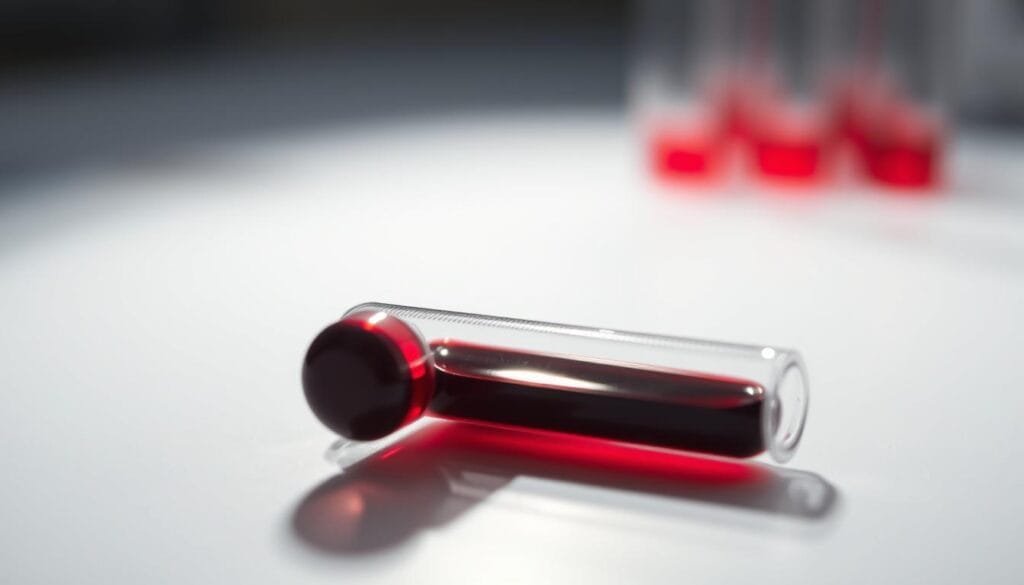Currently Empty: RM0.00
Nearly 250 million preschool children worldwide suffer from vitamin A deficiency, according to the World Health Organization. While rare in developed nations, certain groups—like those with poor diets or malabsorption issues—remain at risk. Recognizing the signs early can prevent long-term health complications.
Common symptoms include night blindness, dry skin, and frequent infections. The body relies on this nutrient for vision, immunity, and cell growth. Plant-based carotenoids (like beta-carotene) and animal-derived retinol are the two primary forms.
Testing and dietary adjustments help maintain optimal levels. For personalized guidance, Wellness Concept in Malaysia offers expert consultations to address nutritional gaps effectively.
Key Takeaways
- Vision problems and dry skin may signal a deficiency.
- Two sources exist: animal-based retinol and plant carotenoids.
- Early detection prevents serious health risks.
- Blood tests confirm nutrient levels accurately.
- Professional consultations ensure tailored solutions.
Understanding Vitamin A and Beta-Carotene
The body processes two distinct forms of this vital nutrient—retinol and carotenoids. As a fat-soluble compound, it supports vision, immune function, and skin repair. Without enough, the body struggles to perform these critical tasks efficiently.
What Is Vitamin A?
This nutrient exists in active and precursor forms. Retinol, the active type, comes from animal products like liver and eggs. Plant-based carotenoids, such as beta-carotene, convert into usable vitamin A during digestion.
“The liver stores retinol, while carotenoids require conversion in the small intestine for absorption.”
Types of Vitamin A: Preformed vs. Provitamin
Preformed vitamin A (retinol) is bioavailable immediately. Provitamin A carotenoids need metabolic processing. Both types contribute to overall health but differ in sources and absorption rates.
| Type | Sources | Absorption Rate |
|---|---|---|
| Retinol | Liver, fish, dairy | Directly utilized |
| Carotenoids | Carrots, spinach, sweet potatoes | Converted as needed |
Daily needs vary by age. Adults typically require 700–900 mcg RAE (Retinol Activity Equivalents). Children and pregnant women often need adjusted amounts for growth and development.
- Animal sources: Beef liver, salmon, fortified milk.
- Plant sources: Kale, red bell peppers, mangoes.
Key Signs You Might Have a Vitamin A Deficiency
The body sends clear signals when essential nutrients are lacking. Persistent issues like dry skin, poor vision, or frequent illnesses often point to a vitamin deficiency. Addressing these early can prevent long-term damage.
Dry Skin and Eczema
Scaly patches or eczema may indicate impaired skin cell regeneration. A study showed 53% improvement in eczema symptoms with proper treatment. Without enough nutrients, the skin struggles to heal and stay hydrated.
Night Blindness and Vision Issues
Difficulty seeing in dim light is an early warning sign. Untreated, it may progress to corneal damage or Bitot’s spots. These white patches on the eyes signal severe night blindness risks.
Frequent Infections
Recurrent colds or respiratory infections suggest weakened immunity. Mucosal barriers rely on this nutrient to block pathogens. Blood tests confirm whether levels are too low.
“Vitamin A deficiency compromises the body’s first line of defense against infections.”
To get enough vitamin A, combine dietary changes with professional guidance. Blood work ensures accurate diagnosis before starting supplements.
Who Is at Risk of Vitamin A Deficiency?
Certain populations face higher risks of nutrient deficiencies due to biological or environmental factors. Limited access to nutrient-rich foods or health conditions disrupting absorption often play key roles. Addressing these gaps early can prevent severe complications.
Pregnant Women and Children
Pregnancy increases nutritional demands by 10–40%. Breastfeeding further depletes stores, raising deficiency risks. UNICEF links childhood blindness to insufficient intake during early development.
- Pregnant women: Require extra retinol for fetal growth.
- Children: Rapid growth phases heighten needs.
- Infants: Rely on maternal reserves or fortified formulas.
People with Malabsorption Conditions
Disorders like Crohn’s disease or cystic fibrosis impair fat-soluble vitamin uptake. Chronic diarrhea or pancreatic issues worsen absorption. Blood tests help identify these hidden gaps.
“Malabsorption syndromes create a vicious cycle—poor nutrient uptake weakens gut repair, perpetuating deficiency.”
| Risk Group | Primary Challenge | Solution |
|---|---|---|
| Pregnant women | Increased nutrient demands | Prenatal supplements |
| Children | Limited diet diversity | Fortified foods |
| Malabsorption patients | Poor intestinal uptake | Water-soluble supplements |
Proactive measures—like tailored supplementation—help at-risk groups maintain balance. Regular monitoring ensures long-term health.
How Vitamin A Deficiency Affects Your Body
Chronic deficiency leaves lasting marks on health and development. Beyond night blindness or dry skin, prolonged insufficiency disrupts immunity, growth, and organ function. Understanding these effects highlights why early intervention matters.
Immune System Vulnerabilities
The immune system relies on this nutrient to maintain barriers in the gut, lungs, and skin. Without enough, pathogens invade more easily. Studies show deficient individuals face twice the risk of respiratory infections.
Synergy with zinc and iron further amplifies protection. A weakened defense system struggles to combat common illnesses, prolonging recovery times.
“Epithelial tissues degrade without adequate vitamin A, turning minor infections into serious threats.”
Stunted Growth and Development
Children suffer disproportionately. Insufficient intake delays bone formation and height growth. An Indonesian trial linked supplements to 0.39cm height gains in malnourished kids.
- Irreversible impacts: Untreated deficits during critical phases hinder brain and organ development.
- Mortality rates: WHO associates deficiency with 23% higher child mortality in at-risk regions.
Blood tests and dietary adjustments can reverse early-stage issues. For severe cases, professional guidance ensures safe supplementation.
Foods Rich in Vitamin A and Beta-Carotene
Boosting nutrient intake starts with choosing the right foods. Animal and plant sources offer distinct forms—retinol and carotenoids—each vital for health. Incorporating these into meals helps maintain optimal levels effortlessly.
Animal Sources (Retinol)
Retinol-rich options provide immediate benefits. Beef liver tops the list with 6,582 mcg per serving—enough to meet weekly needs. Salmon and dairy products like cheese and milk follow closely.
For reference, one large egg offers 75 mcg. Pairing these with healthy fats, like olive oil, enhances absorption. Small servings pack a powerful punch.
Plant Sources (Carotenoids)
Colorful fruits vegetables deliver beta-carotene. A single sweet potato provides 1,403 mcg, while carrots offer 459 mcg per cup. Dark leafy greens like spinach (573 mcg) are equally effective.
“Cooking plant sources lightly increases carotenoid bioavailability by breaking down cell walls.”
Try roasted pumpkin or butternut squash for variety. Combining them with fats—like avocado or nuts—maximizes nutrient uptake. Raw options work, but gentle cooking often yields better results.
- Top picks: Beef liver, sweet potatoes, spinach, carrots.
- Serving tip: ½ cup cooked greens meets 50% of daily needs.
- Recipe idea: Sautéed kale with salmon boosts both retinol and carotenoids.
Testing Your Vitamin A Levels
Accurate testing helps identify nutrient gaps before symptoms worsen. Blood analysis remains the gold standard for measuring retinol levels. Results guide dietary adjustments or supplementation plans effectively.

Blood Tests and Diagnostics
Serum retinol tests detect deficiencies by measuring circulating levels. Values below 20 mcg/dL signal insufficiency, per NIH standards. Retinol-binding protein (RBP) analysis provides additional accuracy.
Inflammation may temporarily skew results, requiring retesting. Follow-up assessments track progress after dietary changes. Combining tests with symptom analysis ensures reliable conclusions.
“RBP measurements account for 90% of circulating retinol, offering precise deficiency detection.”
When to See a Doctor
Persistent symptoms like dry eyes or slow healing warrant professional evaluation. Pregnant women should avoid self-diagnosis due to overdose risks. Medical supervision ensures safe correction.
- Warning signs: Night blindness, frequent infections, skin lesions
- High-risk groups: Children, malabsorption patients, pregnant women
- Testing frequency: Baseline + 3-month follow-up for deficiencies
Clinics like Wellness Concept in Malaysia offer specialized nutrient panels. Their experts interpret complex results and recommend personalized solutions.
Safe Supplementation Practices
Balancing nutrient intake requires understanding safe supplementation limits. While doses vitamin A can address deficiencies, exceeding recommendations risks serious effects. Tailoring intake to gender, age, and health status ensures optimal benefits.
Recommended Daily Allowance
The NIH sets specific guidelines to prevent insufficiency or toxicity. Men need 900 mcg daily, while women require 700 mcg. Children and pregnant women have adjusted needs for growth and development.
| Group | RDA (mcg) | Upper Limit (mcg) |
|---|---|---|
| Adult Men | 900 | 3,000 |
| Adult Women | 700 | 3,000 |
| Pregnant Women | 770 | 3,000 |
“Exceeding 10,000 IU (3,000 mcg) daily may cause dizziness, nausea, or liver damage.” — National Institutes of Health
Risks of Overconsumption
Too much vitamin A, especially from retinol supplements, can be toxic. Symptoms include headaches, dry skin, and in severe cases, teratogenicity during pregnancy. Beta-carotene, however, poses lower risks as the body converts only what it needs.
- Retinoid caution: High doses linked to birth defects in first-trimester pregnancies.
- Liver monitoring: Long-term users should check liver enzymes annually.
- Natural preference: Food sources rarely cause overdose versus synthetic supplements.
For personalized advice, clinics like Wellness Concept in Malaysia assess individual needs safely. Blood tests and professional guidance prevent unintended harm while restoring balance.
Natural Ways to Boost Absorption
Smart food combinations can unlock better nutrient absorption. Diet choices and preparation methods significantly impact how the body uses fat-soluble compounds like carotenoids. Simple tweaks—like adding healthy fats or adjusting heat—enhance bioavailability.
Pairing Foods for Better Uptake
Fat increases carotenoid absorption by 15–50%. Pairing avocado with carrot salads boosts uptake. Olive oil drizzled over tomatoes improves lycopene absorption similarly.
“Anti-nutrients like oxalates in spinach bind to minerals, but steaming reduces their impact.” — Nutrition Research Journal
- Power duos: Salmon with kale, sweet potatoes with coconut oil.
- Avoid inhibitors: Raw nuts with high-oxalate greens.
Cooking Methods That Preserve Nutrients
Gentle heat retains more vitamins than boiling. Steaming broccoli saves 90% of its nutrients versus 40% when boiled. Stir-frying leafy greens balances texture and nutrient retention.
| Method | Nutrient Loss | Best For |
|---|---|---|
| Steaming | 10% | Broccoli, carrots |
| Stir-frying | 15% | Spinach, bell peppers |
| Boiling | 60% | Potatoes (with skin) |
Raw fruits vegetables work for some meals, but lightly cooked options often deliver more accessible nutrients. Experiment to find the right balance for your diet.
Debunking Myths About Vitamin A
Nutrition myths persist despite scientific evidence clarifying the truth. Misguided beliefs about sources, safety, and efficacy often lead to ineffective—or risky—choices. Clearing these misconceptions ensures smarter health strategies.

Carrots Alone Fix Deficiency
While carrots provide beta-carotene, they lack retinol—the active form. The body converts only 45% of carotenoids into usable nutrients. Relying solely on plant sources may not get enough for those with high needs.
“Animal-derived retinol meets 100% of requirements, whereas plant conversion is inefficient for acute deficiencies.” — Journal of Clinical Nutrition
Supplements Are Always Safe
Over-the-counter supplements carry risks like hypervitaminosis A. Symptoms range from nausea to liver damage. Case studies link megadoses to birth defects and bone fractures.
- Topical vs. systemic: Skin retinoids don’t elevate blood levels.
- Natural fallacy: Herbal supplements can still exceed safe limits.
- Fat-soluble danger: Excess stores in the liver, unlike water-soluble vitamins.
Blood tests and professional guidance prevent unintended harm. Balanced diets with diverse forms—retinol and carotenoids—offer safer, sustainable solutions.
Where to Get Help in Malaysia
Addressing nutritional gaps requires expert guidance and accessible solutions. Wellness Concept stands out as Malaysia’s trusted partner for personalized health strategies. Their team combines cutting-edge diagnostics with culturally tailored advice.
Comprehensive Support at Wellness Concept
Certified nutritionists assess levels through in-house blood tests. Custom diet plans account for local food preferences and lifestyle factors. Immediate consultations are available via WhatsApp for urgent queries.
“Precision testing and localized care bridge the gap between theory and practical nutrition.”
Flexible Scheduling for Busy Lifestyles
Clinic hours accommodate working professionals and families:
- Weekdays: 9:30 AM–6:30 PM (Mon–Fri)
- Weekends: 10 AM–5 PM (Sat–Sun)
Walk-ins welcome, but appointments reduce wait times. Services include:
- Retinol and carotenoid body panels
- Supplement safety reviews to minimize risk
- Follow-up plans tracking progress
With clinics across major cities, Wellness Concept makes expert care accessible nationwide. Their approach turns complex science into simple, sustainable habits.
Conclusion
Recognizing a vitamin deficiency early—like night blindness or dry skin—can prevent serious complications. Blood tests offer precise insights into nutrient gaps.
Combining a balanced diet with expert advice ensures the body can get enough essential nutrients. Wellness Concept in Malaysia provides tailored solutions, from testing to meal planning.
Self-prescribing supplements risks toxicity. Always consult professionals for safe adjustments. For quick assessments, message +60123822655 to prioritize your health today.
FAQ
What are the main differences between preformed vitamin A and beta-carotene?
Preformed vitamin A (retinol) comes from animal sources like liver, dairy, and fish. Beta-carotene, a provitamin A carotenoid, is found in colorful fruits and vegetables. The body converts beta-carotene into active vitamin A as needed.
Can vitamin A deficiency cause vision problems?
Yes. Low levels may lead to night blindness or dry eyes. Severe deficiency can even cause irreversible damage to the cornea, known as xerophthalmia.
Which foods provide the highest amounts of vitamin A?
Beef liver, sweet potatoes, carrots, and spinach are excellent sources. Dairy products like milk and cheese also contain retinol, while kale and red peppers offer beta-carotene.
How is vitamin A deficiency diagnosed?
Doctors use blood tests to measure retinol levels. Symptoms like frequent infections or skin issues may prompt testing, especially for high-risk groups like pregnant women.
Are vitamin A supplements safe for everyone?
High doses can be toxic. Pregnant women should avoid excess retinol, which may harm fetal development. Beta-carotene from foods is safer since the body regulates conversion.
Does cooking affect vitamin A in foods?
Light cooking enhances beta-carotene absorption from veggies. However, prolonged high heat may reduce nutrient levels. Pairing with healthy fats like olive oil boosts uptake.
Can you get too much vitamin A from food sources?
Toxicity is rare from diet alone but possible with excessive liver consumption. Symptoms include dizziness and nausea. Stick to recommended daily amounts unless directed otherwise by a healthcare provider.
Where can Malaysians seek help for suspected deficiencies?
Wellness Concept clinics offer consultations and testing. Their nutrition experts provide personalized advice on dietary adjustments or supplements if needed.



